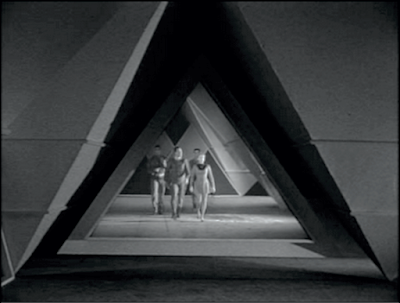On a test flight, Robert Clarke pilots his X-80 (Convair F-102 interceptor) through a time barrier then returns to the airbase finding it deserted with buildings showing decades of neglect. He wanders alone from one building to another. What the...hey! Check out his expression below. Doh! He looks off into a distant forest to see a dark projected painting...uh...futuristic city. He is soon captured and taken to an underground city called the Citadel. Triangles are the dominant architectural theme in this dystopian society. A fantastic city right off a 1938 Popular Science magazine cover. Tall beacons use the pulsating sound effect of the Martian's laser ray appendage from the original The War of The Worlds. The not-so-special effect of what sounds like a sophisticated party favor slide whistle is used for an elevator’s ascent and descent. This was probably not included in the budget.
Vladimir Sokoloff, in one
of his last movie roles, plays the Supreme of the Citadel who is
suspicious of any outsiders. His muted granddaughter, played by
Darlene Tompkins has the singular ability to read minds and affirms
Clarke is quite a catch. The Supreme trusts her telepathy. Planning
to stay at least overnight, Clarke is provided sleeping arrangements
in an open-concept area the size of a small airport terminal. The bed
is an enormous, double queen-sized mattress placed on the floor. A
servant brings him dinner, for which he is grateful because he has not
eaten since who knows when. He takes a bite out of something and proceeds to explore his surroundings. He is stuffed and never
eats again. Clarke and Tompkins get along triangularly. So well, she
slaps him for what he is thinking after their first kiss. At least
she is not sterile like all the others. Wait!
Apparently, America’s
nuclear bomb testing in the Seventies damaged the Earth's atmosphere,
letting dangerous cosmic rays fall back to Earth
causing a plague of massive mutants and stupendous sterility.
Tompkins somehow escapes the latter part and the Supreme hopes Clarke
can regenerate their society. Nudge, nudge. Wink, wink. Speaking of
sterile—unfortunately not
mute—Boyd “Red” Morgan’s
performance as the Captain is just that. A former NFL player and
Hollywood stuntman, his delivery lack any professionalism. What
better film to showcase his talent.
To help him understand the
year 2024―no wonder he was starved―the Citadel’s complete
history is stored in a Zenith record player console cabinet painted
in sterile white. A chronicle only a few geniuses could ever possibly
interpret. Tompkins pulls out shoulder-width portrait images which
Clarke, without hesitation, nails the detailed story behind each.
She nods excessively in approval. He is so dreamy! Oh, he has more
questions. She brings out another portrait to remedy his curiosity.
She nods excessively. I was getting a headache watching her head shake so enthusiastically.
Other time-travelers are
revealed to be living in the Citadel which conflicts with Clarke’s
plan. Each wants to return to their time and will stoop low enough to
make it happen. One traveler releases underground mutants who look
hilariously harmless with choreographed attacks resembling a Kung Fu
gymnastics event. The bare-footed bald mutants, with pant legs, slit
from ankle to knee, laugh maniacally. The Supreme helps Clarke
escape, albeit alone, via the X-80 and return to his airbase with a
hard-to-fathom story to log. Time travel is risky business. In a
popular Twilight Zone twist, Clarke ages, mysteriously, only on
his return trip. He warns them about the dangers of nuclear testing
and of course, man-made global warming, now climate change.
Note: Admittedly, this American-International film will not be on many must-see lists. Unintentionally for reasons the production company could not anticipate. Directed by Edgar Ulmer, of “Detour” movie fame, every penny of its $125,000 budget can be accounted for. And much of the expense went into hiring actors. Handsome Robert Clarke, with his commanding voice, is well known for his low-budget science fiction movies of the Fifties. He was a busy actor on television who seemed to love acting no matter what the project. This film being a good example.






